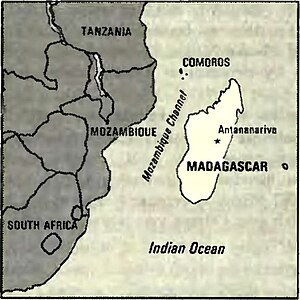The World Factbook (1982)/Madagascar
MADAGASCAR
[edit]
|
| (See reference map VII) |
LAND
[edit]595,700 km2; 5% cultivated, 58% pastureland, 21% forested, 8% wasteland, 2% rivers and lakes, 6% other
WATER
[edit]Limits of territorial waters (claimed): 50 nm (fishing 150 nm; exclusive economic zone 150 nm)
Coastline: 4,828 km
PEOPLE
[edit]Population: 8,992,000 (July 1982), average annual growth rate 2.5%
Nationality:' noun—Malagasy (sing. and pl.); adjective—Malagasy
Ethnic divisions: basic split between highlanders of predominantly Malayo-Indonesian origin, consisting of Merina (1,643,000) and related Betsileo (760,000) on the one hand and coastal tribes—collectively termed the Cotiers—with mixed Negroid, Malayo-Indonesian, and Arab ancestry on the other; coastal tribes include Betsimisaraka 941,000, Tsimihety 442,000, Antaisaka 415,000, Sakalava 375,000; there are also 10-12,000 European French, 5,000 Indians of French nationality, and 5,000 Creoles
Religion: more than half animist; about 41% Christian, 7% Muslim
Language: French and Malagasy official
Literacy: 45% of population age 10 and over
Labor force: about 3.4 million, of which 90% are non-salaried family workers engaged in subsistence agriculture; of 175,000 wage and salary earners, 26% agriculture, 17% domestic service, 15% industry, 14% commerce, 11% construction, 9%services, 6% transportation, 2% miscellaneous
Organized labor: 4% of labor force
GOVERNMENT
[edit]Official name: Democratic Republic of Madagascar
Type: republic; real authority in hands of Supreme Revolutionary Council dominated by President Ratsiraka's AREMA party
Capital: Antananarivo
Political subdivisions: 6 provinces
Legal system: based on French civil law system and traditional Malagasy law; constitution of 1959 modified in October 1972 by law establishing provisional government institutions; new constitution accepted by referendum in December 1975; legal education at National School of Law, University of Madagascar; has not accepted compulsory ICJ jurisdiction
National holiday: Independence Day, 26 June
Branches: executive—a 21-member Supreme Revolutionary Council (made up of military and political leaders); assisted by cabinet called Council of Ministers; People's National Assembly; Military Committee for Development; regular courts are patterned after French system, and a High Council of Institutions reviews all legislation to determine its constitutional validity
Government leader: Cdr. Didier RATS1RAKA, President
Suffrage: universal for adults (18 and above)
Elections: referendum held in December 1975 gave overwhelming approval to government and new constitution; elections for People's National Assembly held in June 1977; only one political grouping allowed to take part in the election, "The Front for the Defense of Malagasy Socialist Revolution," which presented a single list of candidates
Political parties and leaders: 6 parties are now allowed limited political activity under the national front and are represented on the Supreme Revolutionary Council; the 6 parties are: AREMA (President Ratsiraka's Advance Guard of the Malagasy Revolution); AKFM (Pastor Richard Andria-manjato's pro-Soviet Congress Party for Malagasy Independence); VONJY (Dr. Marojama Razanabahiny's Movement for National Unity); UDECMA (Norbert Andriamorasata's Malagasy Christian Democratic Union); MFM (Manandafy Rakotonirina's Militants for the Establishment of a Proletarian Regime); MONIMA (Monja Jaona's National Movement for the Independence of Madagascar) party apparently split over issue of joining national front, leader of faction supporting front unknown, Monja Jaona leads other faction
Voting strength: number of registered voters (1977)—3.5 million; in 1977 local elections, President Ratsiraka's AREMA captured approximately 89.5% of the 73,000 available positions on 11,400 local Executive Committees; AKFM won about 7.3% of the seats, MONIMA 1.7%, and VONJY 1.4%; UDECMA won only about 45 seats
Communists: Communist party of virtually no importance; small and vocal group of Communists has gained strong position in leadership of AKFM, the rank and file of which is non-Communist
Member of: EAMA, FAO, G-77, GATT, IAEA, IBRD, ICAO, ICO, IDA, IFAD, IFC, ILO, IMCO, IMF, ISO, ITU, NAM, OAU, OCAM, UN, UNESCO, UPU, WHO, WMO, WTO
ECONOMY
[edit]GDP: $2.3 billion (1980), about $265 per capita; real growth 4.2% (1980)
Agriculture: cash crops—coffee, vanilla, cloves, sugar, tobacco, sisal, rice, raphia; food crops—rice, cassava, cereals, potatoes, corn, beans, bananas, coconuts, and peanuts; animal husbandry widespread; imports some rice, milk, and cereal
Fishing: catch 51,380 metric tons (1978)
Major industries: agricultural processing (meat canneries, soap factories, brewery, tanneries, sugar refining), light consumer goods industries (textiles, glassware), cement plant, auto assembly plant, paper mill, oil refinery
Electric power: 100,000 kW capacity (1980); 410 million kWh produced (1980), 47 kWh per capita
Exports: $518.0 million (f.o.b., 1980); 30% coffee, 8% vanilla, 7% sugar, 6% cloves; agricultural and livestock products account for about 85% of export earnings
Imports: $724.1 million (f.o.b., 1980); about 19% consumer goods, 21% foodstuffs, 41% primary products (crude oil, fertilizers, metal products), 19% capital goods (1974)
Major trade partners: France (in 1974 accounted for 37% of exports and 48% of imports), US, EC; trade with Communist countries remains a minute part of total trade
Budget: (1980) revenues $521 million (est.), current expenditures $540 million (est.), development expenditures $255 (est.)
Monetary conversion rate: 290 Malagasy francs=US$1
Fiscal year: calendar year
COMMUNICATIONS
[edit]Railroads: 884 km of meter gauge (1.00 m)
Highways: 27,500 km total; 4,694 km paved, 811 km crushed stone, gravel, or stabilized soil; remainder improved and unimproved earth (est.)
Inland waterways: of local importance only, Lake Alaotra, isolated streams and small portions of Canal des Pangalanes
Ports: 4 major (Tamatave, Diego Suarez, Majunga, Tulear)
Civil air: 7 major transport aircraft, including 1 leased out
Airfields: 172 total, 131 usable; 29 with permanent-surface runways; 3 with runways 2,440-3,659 m, 45 with runways 1,220-2,439 m
Telecommunications: fair system, above African average; includes open-wire lines, coaxial cables, and radio-relay links; 1 Indian Ocean satellite station; 37,100 telephones (0.4 per 100 popl.); 11 AM, no FM, and 4 TV stations
DEFENSE FORCES
[edit]Military manpower: males 15-49, 1,972,000; 1,206,000 fit for military service; 84,000 reach military age (20) annually
Military budget: for fiscal year ending 31 December 1981, $114.4 million; about 10.3% of central government budget